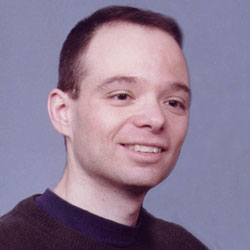| |
| |
| Matthew Kelley, Ph.D., Senior Investigator |
 |
Dr. Kelley received his B.A. degree from Cornell University and his Ph.D. from the University of Virginia where he studied development and regeneration of mechanosensory hair cells with Jeffrey Corwin. After postdoctoral work at the University of Washington studying determination of cell fate in the vertebrate retina with Thomas Reh, he became a faculty member in Cell Biology at Georgetown University in 1996. In 2000 he moved to NIDCD as acting chief of the Section on Developmental Neuroscience. In 1999 he received the Burt Evans Young Investigator Award from the National Organization for Hearing Research. Dr. Kelley�s laboratory is studying the cellular, molecular and genetic interactions that play a role in the determination of cell fate and cellular patterning in the mammalian auditory system.
|

|
Staff:
- Alain Dabdoub, Ph.D., Research Fellow, (301) 435-8074 dabdouba@nidcd.nih.gov
- Elizabeth Driver, Ph.D., Postdoctoral Fellow, (301) 435-8074 drivere@nidcd.nih.gov
- Jose Gurrola, B.A., Predoctoral Fellow, (301) 435-8074 gurrolaj@nidcd.nih.gov
- Bonnie Jacques, B.S., Predoctoral Fellow, (301) 435-8074 jacquesb@nidcd.nih.gov
- Jennifer Jones, B.Sc., Predoctoral Fellow, (301) 435-8074 jonesj2@nidcd.nih.gov
- Mireille Montcouquiol, Ph.D., Research Fellow, (301) 435-8074 montcouq@nidcd.nih.gov
- Kala Puligilla, Ph.D., Postdoctoral Fellow, (301) 435-8074 puligillak@nidcd.nih.gov
- Chad Woods, M.S., Research Assistant, (301) 435-8074 woodsc@nidcd.nih.gov
Research Interests:
Current research in the laboratory is focused on the mechanisms that control the number of cells that will develop with each distinct phenotype. Previous results have demonstrated that the number of cells that will develop as sensory hair cells is regulated through inhibitory interactions between neighboring cells. These results suggest that the possible cell fates within the cochlea may be arranged in a hierarchy and that as the number of cells that become specified to develop as a single phenotype increases, these cells then begin to produce inhibitory signals that force the remaining cells to develop with alternate fates.
A second area of interest is the mechanisms that control overall cellular pattern with the cochlea. The cellular pattern of the mammalian cochlea is arranged in a gradient such that one type of sensory cell is located on one edge of the epithelium and a second type of sensory cell is located on the opposite edge. At both edges the sensory cells are arranged in distinct rows. The factors that specify the formation of this pattern are unknown; however, preliminary results suggest that the Wnt signaling pathway may play a role in the development of this pattern.
The overall goals of the Section on Developmental Neuroscience are to identify the molecular and cellular factors that play a role in the development of the sensory epithelium of the mammalian cochlea (the organ of Corti). The organ of Corti is comprised of at least 6 distinct cell types that are arranged in highly conserved mosaic. The generation of a specific number of each cell type and the arrangement of these cell types into a regular pattern are essential for the normal perception of sound; however, our understanding of the factors that play a role in the development of this structure is extremely limited.
|
Selected Recent Publications:
Daboub, A., Donohue, M.J., Brennan, A., Wolf, V., Montcouquiol, M., Sasson, D.A., Hseih, J.-C., Rubin, J.S., Salinas, P.C. and Kelley, M.W. (2003) Wnt Signaling Mediates Reorientation of Outer Hair Cell Stereociliary Bundles in the Mammalian Cochlea., Development 130, 2375-2384.
Montcouquiol, M., Rachel, R.A., Lanford, P.J., Copeland, N.G., Jenkins, N.A., and Kelley, M.W. (2003) Identification of Vangl2 and Scrb1 as the first planar polarity genes in mammals., Nature 423, 173-176.
Mueller, K.L., Jacques, B.E. and Kelley, M.W. (2002) FGF signaling regulates pillar cell development in the organ of Corti. , Journal of Neuroscience 22, 9368-9377.
R�sch, A., Ng, L., Goodyear, R., Oliver, D., Lisoukov, I., Vennstr�m, B., Richardson, G., Kelley, M.W. and Forrest, D. (2001) Retardation of cochlear maturation and impaired hair cell function caused by deletion of all known thyroid hormone receptors., J. Neurosci. 21, 9792-9800.
Full Text/Abstract
All Selected Publications
Contact Information:
Dr. Matthew Kelley
Laboratory of Cellular Biology, NIDCD
Porter Neuroscience Research Center
Building 35, Room 2A-100
35 Convent Drive, MSC 3729
Rockville, MD 20850-3729
Telephone: (301) 435-8075 (office),
(301) 435-8075 (laboratory),
(301) 435-4481 (fax)
Email: Kelleymt@nidcd.nih.gov
|
|















